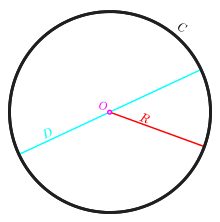Disk (mathematics)

In geometry, a disk (also spelled disc)[1] is the region in a plane bounded by a circle. A disk is said to be closed if it contains the circle that constitutes its boundary, and open if it does not.[2]
Formulas
In Cartesian coordinates, the open disk of center and radius R is given by the formula[1]
while the closed disk of the same center and radius is given by
The area of a closed or open disk of radius R is πR2 (see area of a disk).[3]
Properties
The disk has circular symmetry.
The open disk and the closed disk are not topologically equivalent (that is, they are not homeomorphic), as they have different topological properties from each other. For instance, every closed disk is compact whereas every open disk is not compact.[4] However from the viewpoint of algebraic topology they share many properties: both of them are contractible[5] and so are homotopy equivalent to a single point. This implies that their fundamental groups are trivial, and all homology groups are trivial except the 0th one, which is isomorphic to Z. The Euler characteristic of a point (and therefore also that of a closed or open disk) is 1.[6]
Every continuous map from the closed disk to itself has at least one fixed point (we don't require the map to be bijective or even surjective); this is the case n=2 of the Brouwer fixed point theorem.[7] The statement is false for the open disk:[8]
Consider for example the function which maps every point of the open unit disk to another point on the open unit disk to the right of the given one. But for the closed unit disk fixes every point on the half circle
See also
- Unit disk, a disk with radius one
- Annulus (mathematics), the region between two concentric circles
- Ball (mathematics), the usual term for the 3-dimensional analogue of a disk
- Disk algebra, a space of functions on a disk
- Orthocentroidal disk, containing certain centers of a triangle
References
- 1 2 Clapham, Christopher; Nicholson, James (2014), The Concise Oxford Dictionary of Mathematics, Oxford University Press, p. 138, ISBN 9780199679591.
- ↑ Arnold, B. H. (2013), Intuitive Concepts in Elementary Topology, Dover Books on Mathematics, Courier Dover Publications, p. 58, ISBN 9780486275765.
- ↑ Rotman, Joseph J. (2013), Journey into Mathematics: An Introduction to Proofs, Dover Books on Mathematics, Courier Dover Publications, p. 44, ISBN 9780486151687.
- ↑ Maudlin, Tim (2014), New Foundations for Physical Geometry: The Theory of Linear Structures, Oxford University Press, p. 339, ISBN 9780191004551.
- ↑ Cohen, Daniel E. (1989), Combinatorial Group Theory: A Topological Approach, London Mathematical Society Student Texts, 14, Cambridge University Press, p. 79, ISBN 9780521349369.
- ↑ In higher dimensions, the Euler characteristic of a closed ball remains equal to +1, but the Euler characteristic of an open ball is +1 for even-dimensional balls and −1 for odd-dimensional balls. See Klain, Daniel A.; Rota, Gian-Carlo (1997), Introduction to Geometric Probability, Lezioni Lincee, Cambridge University Press, pp. 46–50.
- ↑ Arnold (2013), p. 132.
- ↑ Arnold (2013), Ex. 1, p. 135.